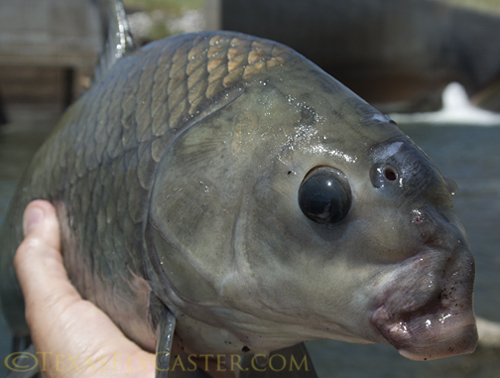Where the Buffalo Roam

Catching local buffalo smallmouth on fly is becoming more consistent these days.
If you are fortunate enough to have ever crossed paths with a fish known as the buffalo smallmouth, then you know the rush you get from trying to catch a fish that seems virtually uncatchable – a fish that demands heavy doses of luck and patience.
To hook a buffalo in the mouth, for me, is still a feat of epic proportions. If you think of a buffalo as a roomba vacuum cleaner, and think of placing a fly in wait for this slimy roomba to hopefully suck it up … even a roomba is more predictable. Remember the slimy roomba’s mouth is about half the size of a common carp’s mouth (pound-for-pound). Common carp are so much more gullible than buffalo – taking moving flies, in a wide variety, and even chasing flies when the mood hits them.
I have caught buffalo below Denison Dam when they were feeling “gamy” and on moving sporting (bait pattern) flies. It is rare, but it does happen. When the clarity is good, we do see them in certain spots on the north side of Ray Roberts. Seeing one of these fish lazily vacuuming the bottom in two to three feet of water is enough to make your heart skip a half beat. They get big, and in that clear water they cast a big shadow. It’s all about the two P’s – placement and patience, and I’ve seen it done, and even done it once or twice. Seriously – once or twice.
While I have a very high success rate for, say sight casting on flats largemouth bass, just the opposite is true for me when it comes to buffalo. The only thing more frustrating – sight casting for these freshwater permit in creeks and rivers. For the longest time catching buffalo on rivers has been like balancing one marble on top of another. Until now.
As I contemplate the dark night of zebra mussels eventually encroaching on Lake Ray Roberts, I have also taken recent words to heart – “Adapt, improvise and overcome.” And the inspiration for a new idea in catching buffalo came, strangely enough, while pursuing the zebra mussels below the Dam.
The water below the Dam last week was low, slow and more clear than I have ever seen it, and thanks to that clarity it was plain to see huge common carp and buffalo, lazily feeding everywhere in the slow current. E V E R Y where.
I made a mental note of the time and where they were feeding, and made plans to return. While the water was very clear, certain times of the day would certainly give me the sight advantage. What were they feeding on? I could only guess it was some of the micro organisms on the rocks, or perhaps small crawfish.
PIECES OF A PUZZLE
As many times as I have fished rivers in a handful of different states, I was always aware of fishing the water column, using split-shot, indicators and whatever it took to find the depth the fish were feeding.
And although it’s pretty common for a buffalo to be indiscriminate about fly type, if they swim for the depths after seeing your fly, it’s a fair bet they won’t vacuum it if it happens to get near their mouth.
I started at midday, the sun straight overhead for maximum visibility of innumerable buffalo and common carp feeding near the Dam. I decided to throw some common carp flies at the dark behemoths with tail widths measuring larger than many fish I’ve caught.
Hours go by with little more than a couple of fish scales to show for the effort. The fish can be so thick that foul hooking is something you have to try to avoid, but sometimes you feel the tug, and your fly is returned, fluttering with a quarter-sized scale neatly impaled.
I can see, or at least I think I can see, the fly in perfect position, and pure rejection. So I go through some flies. Still little more than nothing.
Then, I put on my thinking cap, and put a piece of splitshot about six inches up the fluorocarbon leader. Bingo. Three common carp of extraordinary color, size and strength, followed by three buffalo not too large, but properly hooked, fought and landed. It seems it was less about the changing of the flies, and much more about the water column. Even though I can plainly see what’s going on down there, I may have been fooled by the bending properties of water, or the idea that the current was much less than it really was.
You won’t be seeing these fish in one or two feet of water. They’re in three to five with variable current and visibility. And you won’t be seeing them much at all if the wind ripples the water, or the sun isn’t overhead (the hottest time of day).
While the action on the flats has been generally sporadic this year, I have seen plenty of fly fishers (through message boards) catching numerous buffalo this year. Those I have landed are small by comparison.
Let me know if you want more information on this fishing opportunity. It’s not quite to the point of being fine tuned enough to offer as a trip option, but it’s getting there!

You must be logged in to post a comment.